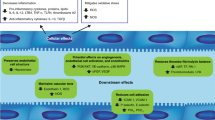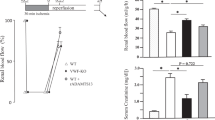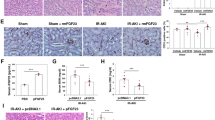Abstract
The present study found that the fifth epidermal growth factor-like domain of thrombomodulin (TME5) possesses the cytoprotective function in association with an increase in levels of anti-apoptotic myeloid cell leukemia-1 protein in an activated protein C-independent manner in human umbilical vein endothelial cells (HUVECs). Importantly, TME5 counteracted calcineurin inhibitor-induced vascular permeability and successfully prevented monocrotaline-induced sinusoidal obstruction syndrome (SOS) in a murine model. Taken together, TME5 may be useful for preventing or treating lethal complications that develop after hematopoietic stem cell transplantation such as SOS and thrombotic microangiopathy in which endothelial cell damage has a role.
This is a preview of subscription content, access via your institution
Access options
Subscribe to this journal
Receive 12 print issues and online access
$259.00 per year
only $21.58 per issue
Buy this article
- Purchase on Springer Link
- Instant access to full article PDF
Prices may be subject to local taxes which are calculated during checkout






Similar content being viewed by others
References
Suzuki K, Kusumoto H, Deyashiki Y, Nishioka J, Maruyama I, Zushi M et al. Structure and expression of human thrombomodulin, a thrombin receptor on endothelium acting as a cofactor for protein C activation. EMBO J 1987; 6: 1891–1897.
Dittman WA, Majerus PW . Structure and function of thrombomodulin: a natural anticoagulant. Blood 1990; 75: 329–336.
Dahlback B, Villoutreix BO . The anticoagulation protein C pathway. FEBS Lett 2005; 579: 3310–3316.
Stearns DJ, Kurosawa S, Esmon CT . Microthrombomodulin. Residues 310–486 from the epidermal growth factor precursor homology domain of thrombomodulin will accelerate protein C activation. J Biol Chem 1989; 264: 3352–3356.
Abeyama K, Stern DM, Ito Y, Kawahara K, Yoshimoto Y, Tanaka M et al. The N-terminal domain of thrombomodulin sequesters high-mobility group-B1 protein, a novel anti-inflammatory mechanism. J Clin Invest 2005; 115: 1267–1274.
Conway EM, Van de Wouwer M, Pollefeyt S, Jurk K, Van Aken H, De Vriese et al. The lectin-like domain of thrombomodulin confers protection from neutrophil-mediated tissue damage by suppressing adhesion molecule expression via nuclear factor kappaB and mitogen-activated protein kinase pathways. J Exp Med 2002; 196: 565–577.
Ikezoe T, Yang J, Nishioka C, Honda G, Furihata M, Yokoyama A . Thrombomodulin protects endothelial cells from a calcineurin inhibitor-induced cytotoxicity by upregulation of extracellular signal-regulated kinase/myeloid leukemia cell-1 signaling. Arterioscler Thromb Vasc Biol 2012; 32: 2259–2270.
Sakai M, Ikezoe T, Bandobashi K, Togitani K, Yokoyama A . Successful treatment of transplantation-associated thrombotic microangiopathy with recombinant human soluble thrombomodulin. Bone Marrow Transplant 2010; 45: 803–805.
Ikezoe T, Togitani K, Komatsu N, Isaka M, Yokoyama A . Successful treatment of sinusoidal obstructive syndrome after hematopoietic stem cell transplantation with recombinant human soluble thrombomodulin. Bone Marrow Transplant 2010; 45: 783–785.
Ikezoe T, Takeuchi A, Taniguchi A, Togitani K, Yokoyama A . Recombinant human soluble thrombomodulin counteracts capillary leakage associated with engraftment syndrome. Bone Marrow Transplant 2011; 46: 616–618.
Carreras E, Diaz-Ricart M . The role of the endothelium in the short-term complications of hematopoietic SCT. Bone Marrow Transplant 2011; 46: 1495–1502.
Ikezoe T, Takeuchi A, Chi S, Takaoka M, Anabuki K, Kim T et al. Effect of recombinant human soluble thrombomodulin on clinical outcomes of patients with coagulopathy after hematopoietic stem cell transplantation. Eur J Haematol 2013; 91: 442–447.
Saito H, Maruyama I, Shimazaki S, Yamamoto Y, Aikawa N, Ohno R et al. Efficacy and safety of recombinant human soluble thrombomodulin (ART-123) in disseminated intravascular coagulation: results of a phase III, randomized, double-blind clinical trial. J Thromb Haemost 2007; 5: 31–41.
Tsubokura M, Yamashita T, Inagaki L, Kobayashi T, Kakihana K, Wakabayashi S et al. Fatal intracranial hemorrhage following administration of recombinant thrombomodulin in a patient after cord blood transplantation. Bone Marrow Transplant 2011; 46: 1030–1031.
James CM. Pichia protocols 2nd edn. Methods in Molecular Biology Vol. 389. Springer: New York, NY, 2007.
Yurimoto H, Yamane M, Kikuchi Y, Matsui H, Kato N, Sakai Y . The pro-peptide of Streptomyces mobaraensis transglutaminase functions in cis and in trans to mediate efficient secretion of active enzyme from methylotrophic yeasts. Biosci Biotechnol Biochem 2004; 68: 2058–2069.
Ikezoe T, Yang Y, Heber D, Taguchi H, Koeffler HP . PC-SPES: a potent inhibitor of nuclear factor-kappa B rescues mice from lipopolysaccharide-induced septic shock. Mol Pharmacol 2003; 64: 1521–1529.
Ikezoe T, Tanosaki S, Krug U, Liu B, Cohen P, Taguchi H et al. Insulin-like growth factor binding protein-3 antagonizes the effects of retinoids in myeloid leukemia cells. Blood 2004; 104: 237–242.
Niimi S, Oshizawa T, Naotsuka M, Ohba S, Yokozawa A, Murata T et al. Establishment of a standard assay method for human thrombomodulin and determination of the activity of the Japanese reference standard. Biologicals 2002; 30: 69–76.
Nakamura K, Hatano E, Miyagawa-Hayashino A, Okuno M, Koyama Y, Narita M et al. Soluble thrombomodulin attenuates sinusoidal obstruction syndrome in rat through suppression of high mobility group box 1. Liver Int 2014; 34: 1473–1487.
Shi CS, Shi GY, Chang YS, Han HS, Kuo CH, Liu C et al. Evidence of human thrombomodulin domain as a novel angiogenic factor. Circulation 2005; 111: 1627–1636.
Cutler C, Kim HT, Ayanian S, Bradwin G, Revta C, Aldridge J et al. Prediction of veno-occlusive disease using biomarkers of endothelial injury. Biol Blood Marrow Transplant 2010; 16: 1180–1185.
Qiao J, Fu J, Fang T, Huang Y, Mi H, Yang N et al. Evaluation of the effects of preconditioning regimens on hepatic veno-occlusive disease in mice after hematopoietic stem cell transplantation. Exp Mol Pathol 2015; 98: 73–78.
Rio B, Andreu G, Nicod A, Arrago JP, Dutrillaux F, Samama M et al. Thrombocytopenia in venocclusive disease after bone marrow transplantation or chemotherapy. Blood 1986; 67: 1773–1776.
Andersson U, Wang H, Palmblad K, Aveberger AC, Bloom O, Erlandsson-Harris H et al. High mobility group 1 protein (HMG-1) stimulates proinflammatory cytokine synthesis in human monocytes. J Exp Med 2000; 192: 565–570.
Huttunen HJ, Fages C, Rauvala H . Receptor for advanced glycation end products (RAGE)-mediated neurite outgrowth and activation of NF-kappaB require the cytoplasmic domain of the receptor but different downstream signaling pathways. J Biol Chem 1999; 274: 19919–19924.
Geiger H, Pawar SA, Kerschen EJ, Nattamai KJ, Hernandez I, Liang HP et al. Pharmacological targeting of the thrombomodulin-activated protein C pathway mitigates radiation toxicity. Nat Med 2012; 18: 1123–1129.
Kuo CH, Sung MC, Chen PK, Chang BI, Lee FT, Cho CF et al. FGFR1 mediates recombinant thrombomodulin domain-induced angiogenesis. Cardiovasc Res 2015; 105: 107–117.
Moll S, Lindley C, Pescatore S, Morrison D, Tsuruta K, Mohri M et al. Phase I study of a novel recombinant human soluble thrombomodulin, ART-123. J Thromb Haemost 2004; 2: 1745–1751.
Nomura S, Ishii K, Maeda Y, Katayama Y, Yagi H, Fujishima N et al. The preventative effects of recombinant thrombomodulin on transplantation-associated coagulopathy after allogeneic hematopoietic stem cell transplantation. J Stem Cell Res Therapy 2014; 4: 247.
Ikezoe T, Yang J, Nishioka C, Yokoyama A . Thrombomodulin alleviates murine GVHD in association with an increase in the proportion of regulatory T cells in the spleen. Bone Marrow Transplant 2015; 50: 113–120.
Ferrara JL, Levine JE, Reddy P, Holler E . Graft-versus-host disease. Lancet 2009; 373: 1550–1561.
Acknowledgements
This study was supported by the Adaptable and Seamless Technology Transfer Program through target-driven R&D, JST, SENSHIN Medical Research Foundation and KAKENHI (26461406).
Author information
Authors and Affiliations
Corresponding author
Ethics declarations
Competing interests
GH is an employee of Asahi Kasei Pharma. The remaining authors declare no competing financial interest.
Rights and permissions
About this article
Cite this article
Ikezoe, T., Yang, J., Nishioka, C. et al. The fifth epidermal growth factor-like region of thrombomodulin exerts cytoprotective function and prevents SOS in a murine model. Bone Marrow Transplant 52, 73–79 (2017). https://doi.org/10.1038/bmt.2016.195
Received:
Revised:
Accepted:
Published:
Issue Date:
DOI: https://doi.org/10.1038/bmt.2016.195
This article is cited by
-
Advances in the diagnosis and treatment of disseminated intravascular coagulation in haematological malignancies
International Journal of Hematology (2021)
-
G-protein coupled receptor 15 mediates angiogenesis and cytoprotective function of thrombomodulin
Scientific Reports (2017)
-
Potentially life-threatening coagulopathy associated with simultaneous reduction in coagulation and fibrinolytic function in pediatric acute leukemia after hematopoietic stem-cell transplantation
International Journal of Hematology (2017)



